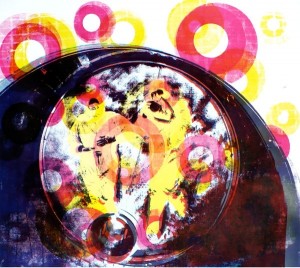Sarah Langston caught up with Sydney screen printer Kate Banazi on how diving into the online sea helps to make ends meet and find new audiences.

Birth In a Petri Dish by Kate Banazi
In the mid 1800s, Victorian novelist Samuel Butler gestured towards the economic tension between art and finance aptly. “The love of money is the root of all evil,” he observed, “The want of money is so, quite as truly.”
This sums up the contradictions facing art practitioners who are confronted with the issue of making their art financially sustainable. In a current marketplace of exploding digital platforms, art makers are reappraising just how to take advantage of developing technologies to keep their passions afloat.
Sydney screen-printer Kate Banazi well understands this tension and the recourse to technology. Looking cheerfully tired, she settles like a rambunctious wren in an oversized violet armchair in an inner city Japanese restaurant. Her paint-encrusted fingernails are evidence that she’s been drawing life from new screens.
Kate originally hails from a thriving community of diverse artists supported by London’s Westminster Council and was educated in Central St Martins, receiving her Honours in fashion. However, it wasn’t long before she hung up her fabric shears for her current, more abstract discipline.

Business Week By Kate Banazi
Arriving on Australian shores three years ago, Kate left behind an established client base. With no art-world connections to speak of, she turned to the Web to push forwards. She used it as a tool for a rebirth of her practice – from the bare earth of finding supplies, to seeking a professional community, to the eventual business of self-promotion in order to sustain her work.
“Before leaving England, a good friend set up my website for me, but it was really just my portfolio, and I didn’t use it much,” Kate says. The said portfolio still exists, offering an overview of her intensely layered screen creations that whip furiously between the delicate and ethereal Birth in a Petri and the attitudinally bold China Goes Shopping.
“When I came to Australia, I had to start everything from scratch, as well as keep in touch with my existing clients in the UK. Soon I used my website much more.”
Like many artists, Kate used her website as a virtual exhibition space as well as a promotional vehicle. However, it was the advent of an online shop linked to her website that allowed Kate to engage with a wider scope of clients, and since doing so she’s seen her work expand both in profitability and audience.
Pricking the shrewd attention of the blogosphere, e-zines, journals and online culture scrapbookers sparked a spreading of the word. Kate’s art has been touted favourably by high calibre bloggers like Poppytalk, Aqua Velvet and Lost at E Minor.
“When I opened my online shop, people really started becoming interested in my prints – it resulted in so much exposure. It was really exciting when Poppytalk picked up a piece. It has been incredibly helpful for getting my work out there,” Kate says.
Kate has also experimented with using online selling communities like Etsy, but she’s found her experiences both spotty and disappointing.
“I think that the technical set up of Etsy creates issues that make it difficult for artists and for customers.”
“There’s also a big issue with people underselling themselves online. There’s just too much competition in places like that and people really under-value their work…For me, Etsy reached the peak of its usefulness in about 2008, and now I’m undecided about how helpful it actually is to what I’m doing.”
When it comes to the buzzing sphere of social media for the task of self-promotion, Kate is not quite ready to step into the hive. She confesses that she personally finds popular tools like Twitter and Facebook more the realm of younger artists.
Online selling and marketing might make an artist more financially viable, but what of the drawbacks? Does it create a discord in the traditional transaction between artist and client, and the intimacy of collecting art?
“Of course there’s less contact, less human interaction and you have to compensate for that. You have to show respect to the people who are buying your art and keeping you going.”
Kate responds to this by ensuring that each item she mails out is packaged lovingly and with care, so that opening it “is like opening a present”. She also encloses a note or complimentary to inject more ‘personality’ and warmth into the exchange.
“It makes the person receiving my work feel connected and as though they’ve received something extra – something of me.”
Kate Banazi’s work can be viewed at www.katebanazi.com.
Sarah Langston
Sarah Langston is an inner-city Sydney based freelance writer, blogger and member of the independent arts community. Sarah works for both love and money – sometimes in combination if she’s lucky. Her time is divided between professional media and marketing roles, and engaging in the emerging writers community as a zinester and poet. Her ultimate professional goal is to hire a cottage on the island of Sifnos and lock the door until she’s produced a book.
 This work is licensed under a Creative Commons Attribution-NonCommercial-ShareAlike 3.0 Australia.
This work is licensed under a Creative Commons Attribution-NonCommercial-ShareAlike 3.0 Australia.







[...] practice and cultural engagement plus he presents the results of recent ANAT studies. Meanwhile Sarah Langston chats to Sydney screen printer Kate Banazi about the benefits of digital platforms for income and [...]